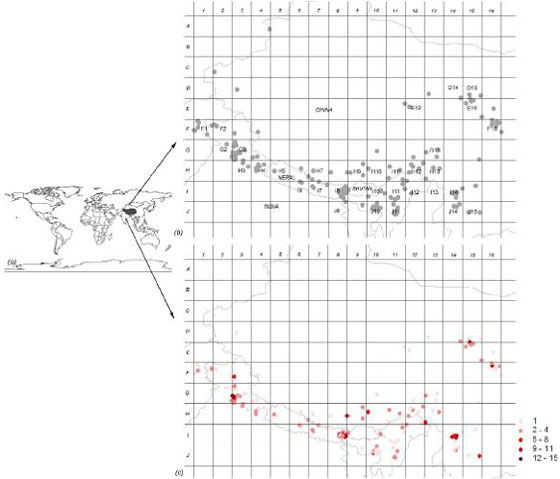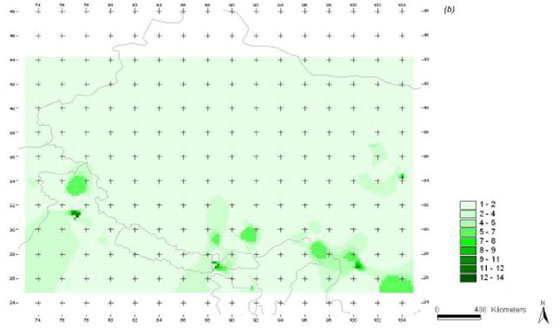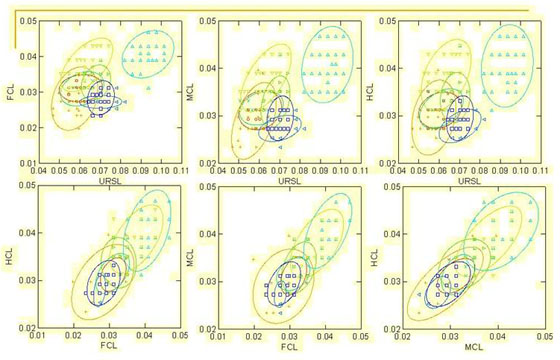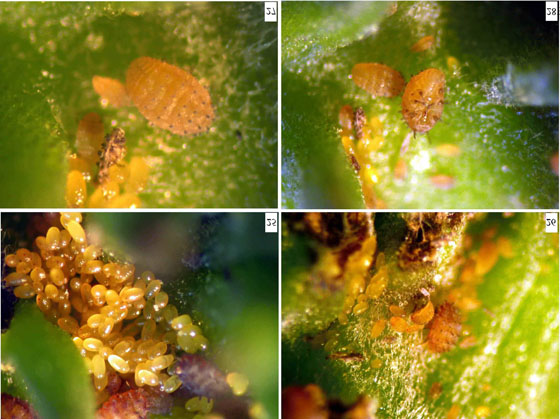1. Aphid taxonomy
2. Aphid systematics and evolution
3. Aphid fauna and biogeography
4. Aphid-host plant interactions
5. Biology and ecology of aphid pests
1. Aphid taxonomy (top)
Before 1949, only 148 aphid species were reported in China. After half an century’s research by members of the lab, more than 1000 aphid species were recorded now, occupying 1/4 of the total number of aphid species in the world. 26 new genera, 422 new species/subspecies have been published. Detailed description of 1036 species of 272 genera, with more than 1200 morphological figures, have been made. Furthermore, more than 30000 sets of aphid specimens have been collected. In China, the lab first applied numerical taxonomic method, chromosome data and embryo setal patterns in aphid taxonomy. The data set of the world aphid genera was developed with G. Remaudière (France), V. F. Eastop (British), O. Holman (Czechoslovakia).
 |
| Akkaia pseudopolygoni Qiao, Jiang and Ren, 2004 |
 |
| Akkaia pseudopolygoni Qiao, Jiang and Ren, 2004 |
We are also doing DNA taxonomy and DNA barcoding work. Now we are doing DNA taxonomy of the Aphidini (Aphidinae) and a DNA barcode dataset of this tribe is developing based on COI sequences. Morphological identification of aphid individuals of the identical species from primary and secondary hosts is always difficult. Our lab has successfully identified the two morph-types of Eriosomatinae aphids by using COI barcodes. Futhermore, cryptic species diversity was revealed by using COI barcodes. The results have been published at Insect Science.
2. Aphid systematics and evolution (top)
(1) Morphological cladistic analysis. Based on morphological studies and a cladistic analysis for representatives of most aphid groups, a 13 families-taxonomic scheme with clearer interrelationships among families/subfamilies was proposed to replace the traditionally confused 11 families-taxonomic scheme. Morphological cladistic analyses were also applied to understand phylogenies of Hormaphidinae, Chaitophorinae and Callaphidinae. As an important morphological character, developmental patterns of setal patterns in embryonic and adult aphids in Hormaphidinae, Callaphidinae have been studied.
(2) Molecular systematics and evolution. We have reconstructed the phylogeny of Aphididae as well as Lachninae, Hormaphidinae and Eriosomatinae by utilizing molecular markers (COI, EF-1a). Based on the molecular phylogeny of gall-inducing group Hormaphidinae and Eriosomatinae, we investigated the evolution of galls. The results in Eriosomatinae showed a distinct trend that aphids tend to gain higher reproductive success by obtaining more nutrition through evolution of gall shapes and positions. The results have been published at Systematic Entomology.
 |
| Evolution of embryo hair arrangement in Cerataphidinae
|
 |
| Gall evolution in Fordini (Eriosomatinae)
|
 |
| Gall evolution direction in Pemphigini (Eriosomatinae) |
3. Aphid fauna and biogeography (top)
Many aphid monographs and regional faunas have been published, which include two volumes of Faunas Sinica on Callaphididae as well as Mindaridae and Pemphigidae, and regional faunas such as ‘Fauna of Agriculture and Forest Aphids in Northwest China’, ‘Insects of the Three Gorge Reservoir Area of Yangtze River’, ‘Forest Insects of Hainan’, ‘Fauna of Insects in Fujian Province of China’, ‘Insects from Maolan Landscape in Guizhou’, ‘Insects of Longwang Shan Nature Reserve’. Moreover, the volume of Faunas Sinica on Hormaphididae and monograph ‘Aphids in Hebei Province’have been finished and is in press.
Based on the faunal studies, we investigated aphid biogeography in the Qinghai-Tibetan Plateau and the Himalayas (QTPH), Northeast China, Beijing and adjacent areas using GIS methods and historical biogeographic methods. For example, GIS investigation of aphid distributions in the QTPH revealed marginal distribution pattern with four distribution centers. By using GIS methods and PAE analysis, areas of endemism of aphids in the QTPH were established, which made a solid foundation to identify the congruent biogeographic patterns and can be used as a testable pattern for other taxa. Our results also discovered that there is a remarkable congruence between centers of endemism and centers of overall species. Related results have been published at Journal of Biogeography and Ecological Entomology.
 |
| Distribution pattern of endemic aphid species in the QTPH
|
 |
| Richness pattern of aphid endemism in the QTPH |
4. Aphid-host plant interactions (top)
We investigated the diversity of host plants of aphids in China and the results indicated a corresponding relationship between genus, specie level of aphids and family, genus level of host plants. By using multivariant statistical analysis of morphological characters of aphids on different types of host plants and feeding positions, such as the leaves of bamboos, plants of Populus, the morphological adaptation of aphids to their host plants were revealed. Morphological characters such as ultimate rostral segments, tarsi and claws which directly contact with the surface of plants showed parallel evolution among different aphid taxa on the same feeding position but divergent evolution on different feeding positions of the same hosts.
 |
| Features of ultimate rostral segments, tarsi and claws |
 |
| PCA analysis of aphid morphological characters |
5. Biology and ecology of aphid pests (top)
From fifties of 20th century, members of the lab studied the biology and ecology of aphid pest species like cotton aphid (Aphis gossypii), Diuraphis agropyronophaga, and soybean aphid (Aphis glycines). Prof. Zhang Guang-Xue and colleagues had successfully popularized their integrated pest management (IPM) approaches involving cultivation modes and natural enemies to control cotton aphid in Yunnan and Liaoning Province. They also popularized integrated approaches to control aphid-transfering viruses in potato and Chinese angelica fields.
We are applying a research project about integrative management of soybean aphid and wheat aphids in China. As an important part of this project, a suction trap network in northern and northeastern China was established to monitor flying aphids and other insects. Population genetics study on soybean aphid is also under research to understand the ecology of aphid pest at molecular level. We are also doing research on biology and ecology of a severe chestnut pest, Moritziella castaneivora. The potential distributions of chestnut phylloxerid was predicted based on GARP and Maxent ecological niche models, which would be helpful for management of this pest. The related results have been published at Journal of Applied Entomology.
 |
| |
 |
| Moritziella castaneivora Miyazaki on Japanese chestnut |
 |
| Aphis glycines Matsumura, 1917
|

